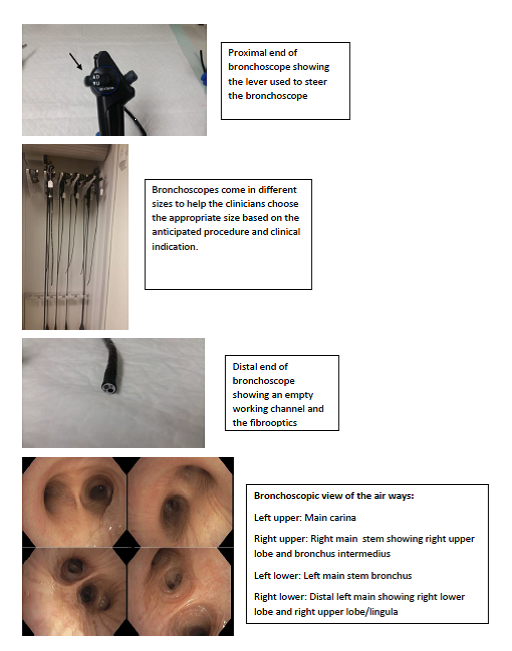[1]
Ninan N, Wahidi MM. Basic Bronchoscopy: Technology, Techniques, and Professional Fees. Chest. 2019 May:155(5):1067-1074. doi: 10.1016/j.chest.2019.02.009. Epub 2019 Feb 16
[PubMed PMID: 30779915]
[2]
Sakpal SV, Donahue S, Crespo HS, Auvenshine C, Agarwal SK, Nazir J, Santella RN, Steers J. Utility of fiber-optic bronchoscopy in pulmonary infections among abdominal solid-organ transplant patients: A comprehensive review. Respiratory medicine. 2019 Jan:146():81-86. doi: 10.1016/j.rmed.2018.12.002. Epub 2018 Dec 12
[PubMed PMID: 30665523]
[3]
Biswas A, Mehta HJ, Sriram PS. Diagnostic Yield of the Virtual Bronchoscopic Navigation System Guided Sampling of Peripheral Lung Lesions using Ultrathin Bronchoscope and Protected Bronchial Brush. Turkish thoracic journal. 2019 Jan 1:20(1):6-11. doi: 10.5152/TurkThoracJ.2018.18030. Epub 2019 Jan 1
[PubMed PMID: 30664420]
[4]
O'Shea C, Khan KA, Tugwell J, Cantillon-Murphy P, Kennedy MP. Loss of flexion during bronchoscopy: a physical experiment and case study of commercially available systems. Lung cancer management. 2017 Dec:6(3):109-118. doi: 10.2217/lmt-2017-0012. Epub 2017 Dec 1
[PubMed PMID: 30643576]
Level 3 (low-level) evidence
[5]
Mohan A, Harris K, Bowling MR, Brown C, Hohenforst-Schmidt W. Therapeutic bronchoscopy in the era of genotype directed lung cancer management. Journal of thoracic disease. 2018 Nov:10(11):6298-6309. doi: 10.21037/jtd.2018.08.14. Epub
[PubMed PMID: 30622805]
[6]
Gendeh BS, Gendeh HS, Purnima S, Comoretto RI, Gregori D, Gulati A. Inhaled Foreign Body Impaction: A Review of Literature in Malaysian Children. Indian journal of pediatrics. 2019 Jan:86(Suppl 1):20-24. doi: 10.1007/s12098-018-2824-8. Epub 2019 Jan 9
[PubMed PMID: 30623311]
[7]
Deshwal H, Avasarala SK, Ghosh S, Mehta AC. Forbearance With Bronchoscopy: A Review of Gratuitous Indications. Chest. 2019 Apr:155(4):834-847. doi: 10.1016/j.chest.2018.08.1035. Epub 2018 Aug 29
[PubMed PMID: 30171862]
[8]
Choo R, Naser NSH, Nadkarni NV, Anantham D. Utility of bronchoalveolar lavage in the management of immunocompromised patients presenting with lung infiltrates. BMC pulmonary medicine. 2019 Feb 26:19(1):51. doi: 10.1186/s12890-019-0801-2. Epub 2019 Feb 26
[PubMed PMID: 30808314]
[9]
Agarwal S, Hoda W, Mittal S, Madan K, Hadda V, Mohan A, Bharti SJ. Anesthesia and anesthesiologist concerns for bronchial thermoplasty. Saudi journal of anaesthesia. 2019 Jan-Mar:13(1):78-80. doi: 10.4103/sja.SJA_640_18. Epub
[PubMed PMID: 30692896]
[10]
Jakubczyc A, Neurohr C. [Diagnosis and Treatment of Interstitial Lung Diseases]. Deutsche medizinische Wochenschrift (1946). 2018 Dec:143(24):1774-1777. doi: 10.1055/a-0622-9299. Epub 2018 Dec 3
[PubMed PMID: 30508858]
[11]
Krishnan S, Kniese CM, Mankins M, Heitkamp DE, Sheski FD, Kesler KA. Management of broncholithiasis. Journal of thoracic disease. 2018 Oct:10(Suppl 28):S3419-S3427. doi: 10.21037/jtd.2018.07.15. Epub
[PubMed PMID: 30505529]
[12]
Thakkar HS, Hewitt R, Cross K, Hannon E, De Bie F, Blackburn S, Eaton S, McLaren CA, Roebuck DJ, Elliott MJ, Curry JI, Muthialu N, De Coppi P. The multi-disciplinary management of complex congenital and acquired tracheo-oesophageal fistulae. Pediatric surgery international. 2019 Jan:35(1):97-105. doi: 10.1007/s00383-018-4380-8. Epub 2018 Nov 3
[PubMed PMID: 30392126]

